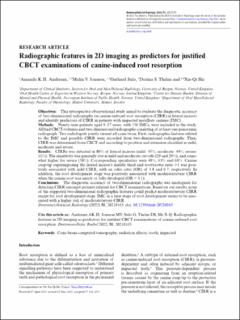| dc.contributor.author | Andresen, Amanda Karoline Helsøe | |
| dc.contributor.author | Jonsson, Malin Viktoria | |
| dc.contributor.author | Sulo, Gerhard | |
| dc.contributor.author | Thelen, Dorina Sula | |
| dc.contributor.author | Shi, Xie-Qi | |
| dc.date.accessioned | 2022-03-04T09:36:20Z | |
| dc.date.available | 2022-03-04T09:36:20Z | |
| dc.date.created | 2021-09-01T20:36:25Z | |
| dc.date.issued | 2022 | |
| dc.identifier.issn | 0250-832X | |
| dc.identifier.uri | https://hdl.handle.net/11250/2983039 | |
| dc.description.abstract | Objectives:
This retrospective observational study aimed to evaluate the diagnostic accuracy of two-dimensional radiographs on canine-induced root resorption (CIRR) in lateral incisors and identify predictors of CIRR in patients with impacted maxillary canines (IMC).
Methods:
Ninety-nine patients aged 9–17 years, with 156 IMCs, were included in the study. All had CBCT-volumes and two-dimensional radiographs consisting of at least one panoramic radiograph. Two radiologists jointly viewed all cases twice. First, radiographic features related to the IMC and possible CIRR were recorded from two-dimensional radiographs. Then, CIRR was determined from CBCT and according to position and extension classified as mild, moderate and severe.
Results:
CIRRs was detected in 80% of lateral incisors (mild: 45%; moderate: 44%; severe: 11%). The sensitivity was generally low at mild and moderate cut-offs (29 and 29%), and somewhat higher for severe (50%). Corresponding specificities were 48%, 63% and 68%. Canine cusp-tip superimposing the lateral incisor’s middle third and root/crown ratio >1 was positively associated with mild CIRR, with an odds ratio (OR) of 3.8 and 6.7, respectively. In addition, the root development stage was positively associated with moderate/severe CIRR when the canine root was nearly or fully developed (OR = 3.1).
Conclusions:
The diagnostic accuracy of two-dimensional radiographs was inadequate for detecting CIRR amongst patients referred for CBCT examinations. Based on our results, none of the suggested two-dimensional radiographic features could predict moderate/severe CIRR except for root development stage. IMC in a later stage of root development seems to be associated with a higher risk of moderate/severe CIRR. | en_US |
| dc.language.iso | eng | en_US |
| dc.publisher | British Institute of Radiology | en_US |
| dc.rights | Navngivelse 4.0 Internasjonal | * |
| dc.rights.uri | http://creativecommons.org/licenses/by/4.0/deed.no | * |
| dc.title | Radiographic features in 2D imaging as predictors for justified CBCT examinations of canine-induced root resorption | en_US |
| dc.type | Journal article | en_US |
| dc.type | Peer reviewed | en_US |
| dc.description.version | publishedVersion | en_US |
| dc.rights.holder | Copyright 2022 The Authors | en_US |
| dc.source.articlenumber | 20210165 | en_US |
| cristin.ispublished | true | |
| cristin.fulltext | original | |
| cristin.qualitycode | 1 | |
| dc.identifier.doi | 10.1259/dmfr.20210165 | |
| dc.identifier.cristin | 1930619 | |
| dc.source.journal | Dentomaxillofacial Radiology | en_US |
| dc.relation.project | Norges forskningsråd: | en_US |
| dc.relation.project | Egen institusjon: | en_US |
| dc.identifier.citation | Dentomaxillofacial Radiology. 2022, 51 (1), 20210165. | en_US |
| dc.source.volume | 51 | en_US |
| dc.source.issue | 1 | en_US |

